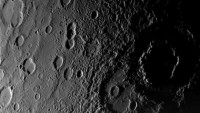NASA All Set To Help Humans Land On Mars' Tiny Moon Phobos And On The Martian Surface; Is It Just A Pipe Dream?
| Vinay Patel | | May 13, 2015 04:33 PM EDT |
NASA plans to send humans on Mars by 2033 and the path to the Red Planet may go through its tiny moon Phobos.
Conceding that NASA receives the necessary funding and makes the technological advances in space travel, the first humans could land on Phobos, the Red Planet's moon by 2033, and on the Martian surface by 2039, according to The National Aeronautics and Space Administration (NASA).
Like Us on Facebook
NASA scientists are apparently not counting on another "John F. Kennedy moment," which occurred back in 1961 when the president called to land people on the moon. This boosted its budget, reaching 4.5 percent share of federal budget during the pinnacle of the Apollo years.
That said, currently it is less than 0.5 percent and NASA is all set to take things slowly by anticipating various mission that will guarantee safe landing on Phobos by 2033, and on Mars after that, according to records on Space.com.
"Landing on Mars isn't just a pipe dream. It's achievable," Charles Bolden, NASA Administrator said.
According to Bolden, Mars matters to humanity and the quest of human progress. In 2016, NASA will launch ExoMars orbiter developed to circle Mars, and there are plans to launch another Mars rover in 2018. Bolden said although robots are suited for preparation and preliminary date, humans are needed on the Martian surface.
The march to Mars is already started, as rovers Curiosity and Opportunity continue to roam the surface and send back important data, photos along with other information about the Red Planet. According to records on Science Times, recent data collected by the rovers hint that Mars could have once supported microbial life.
Another study that boosts the hope of humans surviving on Mars was conducted by a team of scientists spearheaded by NASA's Geronimo Villanueava of the Goddard Space Flight Center. According to the study, the Red Planet had an ocean covering 19 percent of its surface 4 billion years ago.
NASA's technology that's already under development such as Space Launch System (SLS) megarockets and Orion crew capsule are factors on which landing on Phobos will rely on.
TagsMars, Phobos, NASA, The Red Planet, Man on Mars, Martian Surface
©2015 Chinatopix All rights reserved. Do not reproduce without permission
EDITOR'S PICKS
-

Did the Trump administration just announce plans for a trade war with ‘hostile’ China and Russia?
-

US Senate passes Taiwan travel bill slammed by China
-

As Yan Sihong’s family grieves, here are other Chinese students who went missing abroad. Some have never been found
-

Beijing blasts Western critics who ‘smear China’ with the term sharp power
-

China Envoy Seeks to Defuse Tensions With U.S. as a Trade War Brews
-

Singapore's Deputy PM Provides Bitcoin Vote of Confidence Amid China's Blanket Bans
-

China warns investors over risks in overseas virtual currency trading
-

Chinese government most trustworthy: survey
-

Kashima Antlers On Course For Back-To-Back Titles
MOST POPULAR
LATEST NEWS
Zhou Yongkang: China's Former Security Chief Sentenced to Life in Prison

China's former Chief of the Ministry of Public Security, Zhou Yongkang, has been given a life sentence after he was found guilty of abusing his office, bribery and deliberately ... Full Article
TRENDING STORY

China Pork Prices Expected to Stabilize As The Supplies Recover

Elephone P9000 Smartphone is now on Sale on Amazon India

There's a Big Chance Cliffhangers Won't Still Be Resolved When Grey's Anatomy Season 13 Returns

Supreme Court Ruled on Samsung vs Apple Dispute for Patent Infringement

Microsoft Surface Pro 5 Rumors and Release Date: What is the Latest?











